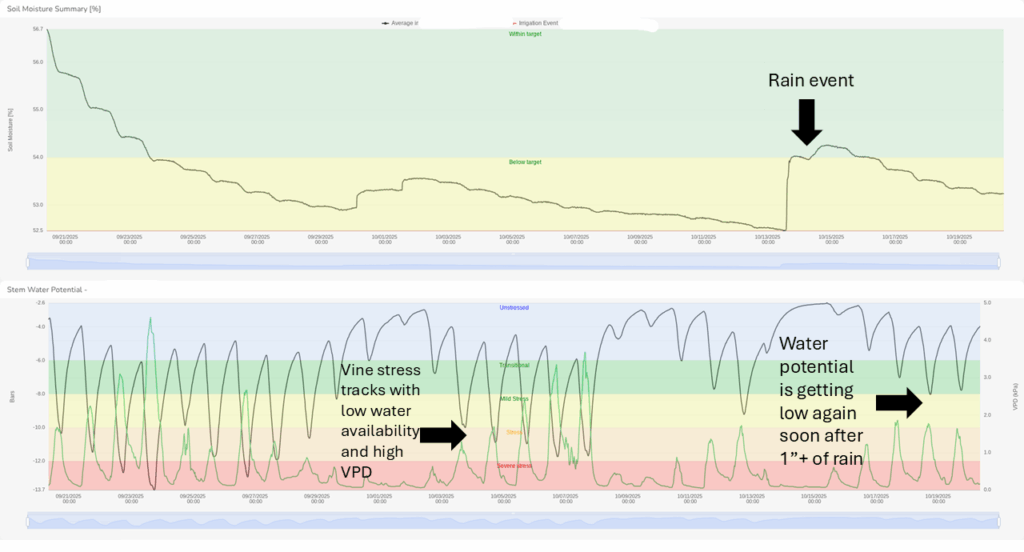Up and down the California Coast, we got some rain last week. Up North, places got around 1.3” with up to 2” closer to the ocean. Down south in Paso Robles, we’re looking similar numbers of between 1.5” and 2”. So, one would naturally think that if we were irrigating post-harvest (as we highly recommend), we can stop now. As you may have suspected by the title of this article, that may or may not be the case.
Profile Picture
Here at AV, we love looking at soil moisture charts. However, in the case of rainfall, it can be misleading. Looking at the graph below, you can see that irrigations produce a clear spike indicating how deeply water percolated and how long it took to be completely depleted by plant roots. Rain doesn’t deliver the same concentrated volume you’re used to getting with a drip emitter. Therefore it doesn’t infiltrate the soil in the same way. You may see shallower percolation from the inch plus of rain we got, but that doesn’t mean the rain was insignificant since it wets a much larger surface area than drip irrigation.

Soil moisture probes do a good job of showing your soil’s water holding capacity. That’s what I put more stock in rather than comparing a rain storm to irrigations. In the graph below, we see that the average soil moisture (average of moisture at all sensor depths from 8” to 48”) is slower to deplete when compared to the previous irrigations, where water was rapidly drawn up. This isn’t always the case.

In this graph for however, we see that after the recent rainfall, average soil moisture is right back to where it was prior to the rain. Assuming vines haven’t entered dormancy, this site should continue to be irrigated.

What about plant stress?
We don’t water just for the sake of the soil. We care about what a lack of water does to the vine’s physiology. And right now, we want vines nice and happy…not so happy they start putting out new growth, but that’s hard to do. An unstressed vine has a functioning canopy that can produce sugar. With the fruit gone, that sugar gets stored in the woody permanent parts of the vine and used the following season to grow leaves and shoots. Eventually, the canopy will start earning its keep but before then the canopy relies on these stores from the wood.
Vine stress (water potential) is not just a function of water availability. Its also a function of vapor pressure deficit…and salinity…but that’s another article. Vapor pressure deficit is the discrepancy between how much moisture the air could hold and how much it’s actually holding. When temperatures are hot, the air can hold a lot more water in suspension than when it’s cold. That’s why things are dewy in the morning. Water potential, which is essentially just the tension of water moving through the plant’s body, responds to this atmospheric pull of moisture.
When it rains, VPD is very low because humidity is 100%. Vines aren’t just unstressed because there’s plenty of water available. They’re also unstressed because the atmosphere isn’t pulling water out of their tissues.

Even if a rainstorm fails to deliver much water, vines are unstressed. It doesn’t mean it will stay this way though. Late season heat happens here in California and if you stopped watering completely because you assumed the soil profile is full, think again. If the profile is back to being dry and we get some heat, your vines can easily get stressed again.
Get your macros in, bro
One of the main reasons to keep irrigating is to apply some fertilizer. Harvested fruit removes roughly 3 lbs nitrogen and 11 lbs potassium per ton. Applying an N-P-K fertilizer through the drip post-harvest puts some of these removed nutrients back into the system. Later, cool years like this one make getting in this final application difficult, but if you can squeeze it in, it makes a big difference when it comes to early canopy establishment the following season.
Conclusion
Should you irrigate or not? Ideally, you get yourself some soil moisture probes and find out. Otherwise, my general advice is if you’re on a lighter soil or one with poor percolation, I wouldn’t take the rain as a sign that your work here is done. Keep irrigating regularly until leaf fall is the best way to ensure maximize recovery and set yourself up for success next season.
